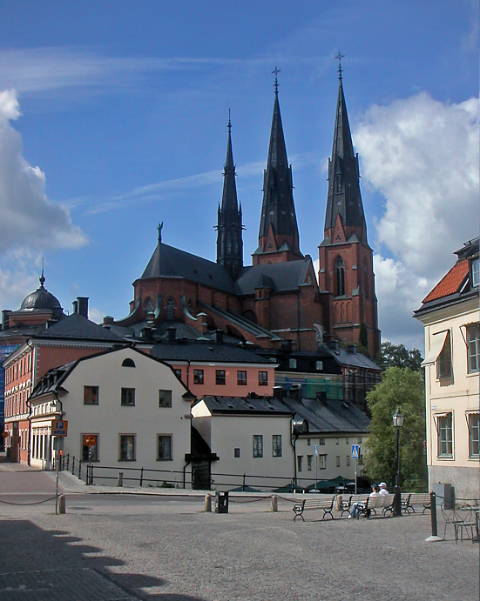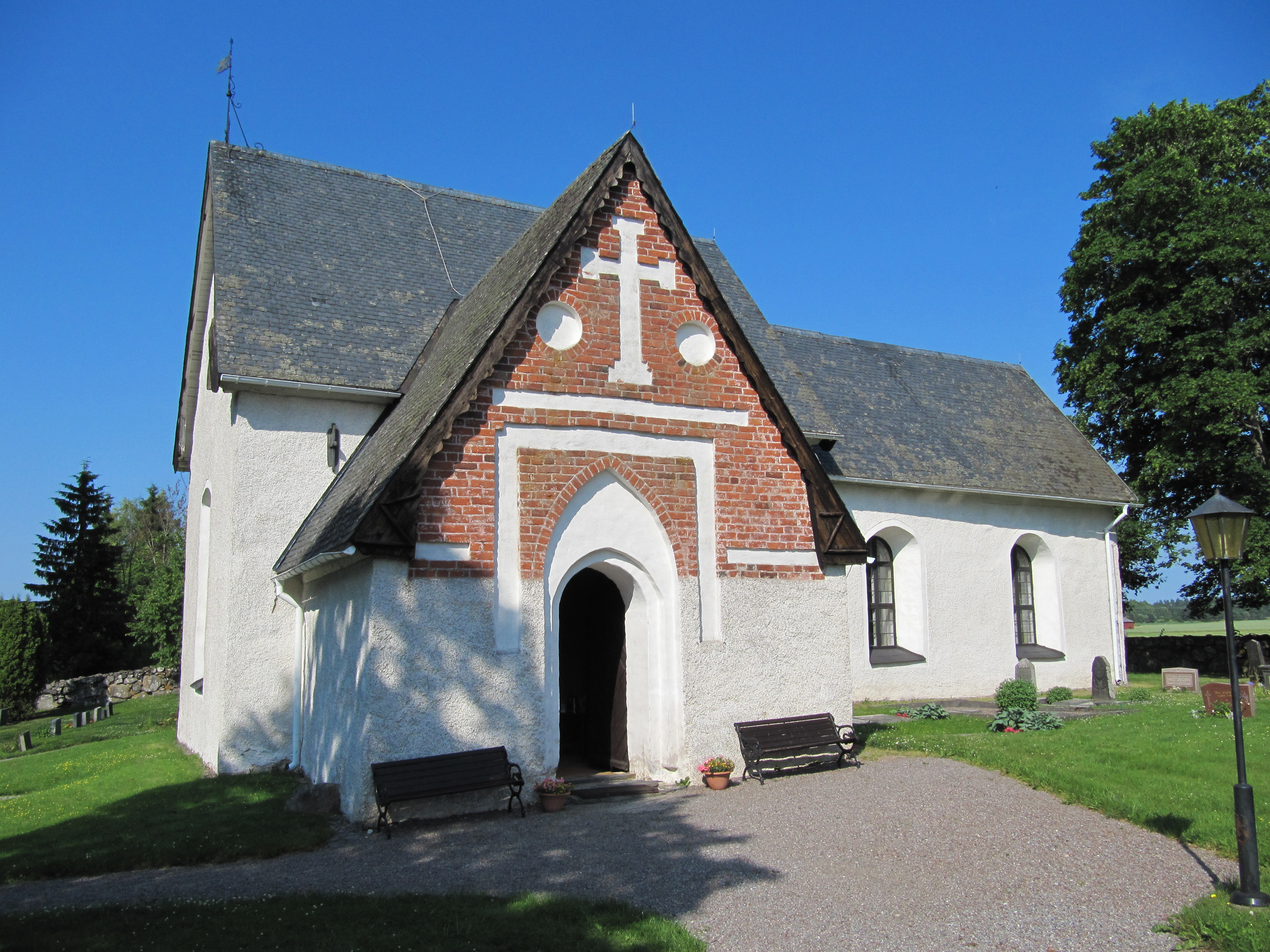|
Södermanland Runic Inscription 226
Södermanland Runic Inscription 226 or Sö 226 is the Rundata catalog listing for a Viking Age memorial runestone located in Norra Stutby, which is about eight kilometers north of Sorunda, Stockholm County, Sweden, which was in the historic province of Södermanland. Description The inscription on Sö 226 consists of runic text in the younger futhark that is carved on a serpent that circles along the outline of the stone, which is about 1.8 meters in height. A figure of a horse is in inside the serpent at the top of the stone. The horse, which is clearly a stallion as indicated by the phallus, is depicted with crossed legs to indicate powerlessness. The combination of symbols of fertility and powerlessness on the horse may indicate regeneration or salvation. Several other Scandinavian runestones include depictions of horses, including DR 96 in Ålum, N 61 in Alstad, Sö 101 in Ramsundsberget, Sö 239 in Häringe, Sö 327 in Göksten, U 375 in Vidbo, U 488 in Harg, U 599 in ... [...More Info...] [...Related Items...] OR: [Wikipedia] [Google] [Baidu] |
Ålum Runestones
The Ålum Runestones are four Viking Age memorial runestones which are located at the church in Ålum, which is west of Randers, Denmark. One of the stones refers to a man with the title drengr and two of the other stones were raised by the same family. Ålum 1 The inscription on Ålum 1, listed as DR 94 in the Rundata catalog, consists of several lines of runic text in the younger futhark on the face of a granite stone in height. The inscription is classified as being carved in runestone style RAK, which is considered to be the oldest classification. This is the classification for inscriptions where the runic text bands have straight ends without any attached serpent or beast heads. The runestone was discovered in 1843 broken into three sections and used in the southeast corner of the church porch. Prior to the understanding of the historic significance of runestones, there were often re-used in the construction of roads, bridges, and buildings such as churches. The sections we ... [...More Info...] [...Related Items...] OR: [Wikipedia] [Google] [Baidu] |
Runemaster
A runemaster or runecarver is a specialist in making runestones. Description More than 100 names of runemasters are known from Viking Age Sweden with most of them from 11th-century eastern Svealand.The article ''Runristare'' in ''Nationalencyklopedin'' (1995). Many anonymous runestones have more or less securely been attributed to these runemasters. During the 11th century, when most runestones were raised, there were a few professional runemasters. They and their apprentices were contracted to make runestones and when the work was finished, they sometimes signed the stone with the name of the runemaster. Many of the uncovered runic inscriptions have likely been completed by non-professional runecarvers for the practical purposes of burial rites or record-keeping. Due to the depictions of daily life, many of the nonprofessional runecarvers could have been anything from pirates to soldiers, merchants, or farmers. The layout of Scandinavian towns provided centers where craftspeople ... [...More Info...] [...Related Items...] OR: [Wikipedia] [Google] [Baidu] |
Runestone Style
:''The term "runestone style" in the singular may refer to the Urnes style.'' The style or design of runestones varied during the Viking Age. The early runestones were simple in design, but towards the end of the runestone era they became increasingly complex and made by travelling runemasters such as Öpir and Visäte. A categorization of the styles was developed by Anne-Sophie Gräslund in the 1990s. Her systematization is considered to have been a break-through and is today a standard. The styles are RAK, Fp, Pr1, Pr2, Pr3, Pr4 and Pr5, and they cover the period 980-1130, which was the period during which most runestones were made. The styles Pr1 and Pr2 correspond to the Ringerike style, whereas Pr3, Pr4 and Pr5 belong to what is more widely known as the Urnes style.Sawyer 2000:32 Below follows a brief presentation of the various styles by showing sample runestones according to Rundata's annotation. RAK RAK is the oldest style and covers the period 980-1015 AD, but th ... [...More Info...] [...Related Items...] OR: [Wikipedia] [Google] [Baidu] |
Uppsala Cathedral
Uppsala Cathedral () is a cathedral located between the University Hall (Uppsala University), University Hall of Uppsala University and the Fyris river in the centre of Uppsala, Sweden. A church of the Church of Sweden, the national church, in the Lutheranism, Lutheran tradition, Uppsala Cathedral is the seat of the Archbishop of Uppsala, the primate of Sweden. It is also the burial site of King Eric IX of Sweden, Eric IX (c. 1120–1160, reigned 1156–1160), who became the patron saint of the nation, and it was the traditional location for the coronation of new King of Sweden, Kings of Sweden. The current archbishop is Martin Modéus and the current bishop is Karin Johannesson. The cathedral dates to the late 13th century and, at a height of , it is the tallest church in the Nordic countries. Originally built under Roman Catholicism, it was used for coronations of Swedish monarchs for a lengthy period following the Protestant Reformation. Several of its chapels were converted ... [...More Info...] [...Related Items...] OR: [Wikipedia] [Google] [Baidu] |
Böksta Runestone
The Böksta runestone is a Viking Age memorial runestone that is located near the farm of Böksta in Balingsta, which is about four kilometers southwest of Ramstalund, Uppsala County, Sweden, in the historic province of Uppland. It is situated not far from Balingsta Church. Description The Böksta Runestone, which is made of granite and is 2.6 meters in height, is notable for its images of a man on horseback holding a spear who is hunting an animal that may be an elk (moose) with two dogs and two birds. One of the birds is attacking the eyes of the hunted animal, which is consistent with past practices when hunting with birds. Finds from graves indicate that falconry has been practiced in Sweden since the 6th century. Observing the hunter is another man on skis, holding a bow and arrow. Surrounding the hunting scene is the runic text inscribed within a serpent. The inscription is believed to date from approximately 1050 CE and is tentatively classified as being carved in run ... [...More Info...] [...Related Items...] OR: [Wikipedia] [Google] [Baidu] |
Uppland Runic Inscription 448
This runic inscription, designated as U 448 in the Rundata catalog, is on a Viking Age memorial runestone located in Harg, which is about 4 kilometers north of Märsta, Stockholm County, Sweden, which was in the historic province of Uppland. Description The design of this inscription consists of runic text inscribed within a serpent band, which circles the stylized figures of a man on a horse and of a bird. The stone is composed of granite and is 1.9 meters in height. The inscription is tentatively classified as being carved in runestone style Pr3, which is also known as Urnes style. This runestone style is characterized by slim and stylized animals that are interwoven into tight patterns. The animal heads on Pr3 inscriptions are typically seen in profile with slender almond-shaped eyes and upwardly curled appendages on the noses and the necks. Based on stylistic analysis, the inscription has been attributed to the Swedish runemaster Fot, [...More Info...] [...Related Items...] OR: [Wikipedia] [Google] [Baidu] |
Vidbo Runestones
The Vidbo Runestones are two Viking Age memorial runestones located in the churchyard of the Vidbo church, about east of Knivsta, Uppsala County, Sweden, in the historic province of Uppland. U 375 Uppland Runic Inscription 375 or U 375 is the Rundata catalog listing for one of the granite runestones, which is 1.9 meters in height. It consists of runic text carved in the Younger Futhark on two serpents which bracket a figure on a horse and a bird. Several other Scandinavian runestones include depictions of horses, including Ålum Runestones#Ålum 3, DR 96 in Ålum, N 61 in Alstad, Sigurd stones#Sö 101, Sö 101 in Ramsundsberget, Södermanland Runic Inscription 226, Sö 226 in Norra Stutby, Södermanland Runic Inscription 239, Sö 239 in Häringe, Sigurd stones#Sö 327, Sö 327 in Göksten, Uppland Runic Inscription 448, U 488 in Harg, U 599 in Hanunda, U 691 in Söderby, Böksta Runestone, U 855 in Böksta, U 901 in Håmö, U 935 at the Uppsala Cathedral, and U 1003 in Frötuna. T ... [...More Info...] [...Related Items...] OR: [Wikipedia] [Google] [Baidu] |



